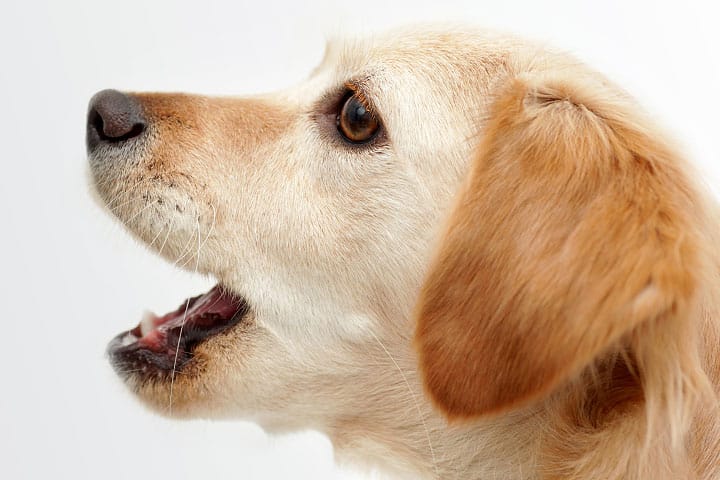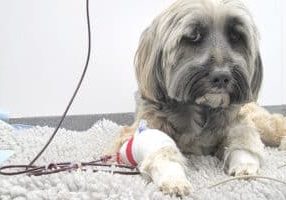
Chronic coughing can impact a pet’ s quality of life. Although a number of antitussive drugs and strategies exist, management can be frustrating due to inconsistent efficacy, which can reduce further over time.
Other issues include adverse effects, cost of medication, and availability. A perfect antitussive drug does not yet exist and medications targeting new pathways and receptors are under development.
Cough Physiology:
Coughing is a complex involuntary reflex in dogs and cats triggered by chemical, mechanical or inflammatory stimuli. Cough receptors are located in the larynx, trachea and bronchi (but not the smaller bronchi, bronchioles or alveoli).
Is an Antitussive Indicated?
Although a cough is a protective mechanism, chronic coughing can promote airway inflammation and damage, as well as impairing quality of life and sleep if uncontrolled. Care must be taken not to suppress a beneficial cough. In general, antitussives are most appropriate if a cough is chronic (present for more than two months) and unproductive. Before prescribing, we should ask:
- Are antitussives contraindicated? Examples include a productive cough, an infectious cause, inhalation of foreign material, or significant central nervous system depression.
- Would better control of the cough be achieved through medication directly targeting the underlying cause/condition?
- Have potential adverse effects been considered?
Antitussive Medications:
Antitussive drugs currently available are broadly divided into opioid and non-opioid groups. Opioids are generally the most effective and are used most widely for dogs. Adverse effects (constipation, sedation, respiratory depression, possibly excitement) are encountered more commonly in cats, therefore non-opioids (e.g. dextromethorphan) have been suggested to be most appropriate in this species (Hsieh and Beets 2020).
| Antitussive Medications | |||
| Group | Drug | Mechanism | Dose |
| Non-opioid | Dextromethorphan | A ‘morphinan’, acts at many receptors, minimal mu activity | Dogs: 0.5-1mg/kg PO q8-12h.
Cats: 2-3mg/kg PO q8-12h.
Suggested safest option for cats (Hsieh and Beets 2020). Poor bioavailaibility and rapid elimination. Availability issues.
|
| Opioid | Diphenoxylate and atropine |
Central effects. Mu opioid receptor agonists, possibly effects at other opioid receptors. Atropine reduces mucus production and facilitates bronchodilation.
|
Dogs: 0.2-0.5mg/ kg q12h
Effective but currently very expensive to obtain in the UK (January 2021).
|
| Codeine | 0.3-2mg/kg PO q6-12h.
Less potent antitussive than butorphanol or diphenoxylate.
|
||
| Butorphanol | Dogs: 0.55–1.1 mg/kg, PO, q6- 12h.
Cats: 0.1–0.4 mg/ kg, SC, q6-12h.
Potent antitussive, but currently unavailable in UK in tablet form. Injectable formulation has been used per os, but dosing schedule not welldefined (Rozanski 2014).
|
||
| Hydrocodone tartrate | Dogs: 0.25mg/kg q6-12h.
Avoid use in cats.
|
||
| Dihydrocodeine tartrate | Dogs: 2mg/kg q8-12h. | ||
Other strategies:
Changes to a pet’ s environment (including reducing exposure to allergens, dust or smoke), gentle exercise and nebulisation may help to alleviate coughing. Bronchodilator, anti-inflammatory and anti-histamine medications can reduce coughing in some settings. As respiratory secretions may be viscous, mucolytics and expectorants may aid clearance by the mucociliary escalator.
| Mucolytics and Expectorants | |||
| Drug | Mechanism | Dose | Contraindications |
| Acetylcysteine | Mucolytic – disrupts mucoprotein disulphide bonds. | 10mg/kg PO q12h. | Avoid nebulisationin cats – causes bronchoconstriction(Reneiro et al. JFMS 2011).
Dogs: 50ml/kg for 30 minutes q12h as an aerosol. |
| Bromhexine | Mucolytic – increases lysosomal activity | 2mg/ kg PO q12h for 7-10 days, then 1mg/ kg PO q12h for a further 7-10 days. | Avoid nebulisation in cats – causes bronchoconstriction (Reneiro et al. JFMS 2011).
Dogs: 50ml/kg for 30 minutes q12h as an aerosol. |
| Guaifenesin | Expectorant | 3-5mg/ kg PO q8h. | Conflicting evidence over whether safe for cats with recent review advising against its use (Hsieh and Beets 2019) |
Emerging options:
There is some evidence to support antitussive effects of medications currently licensed for other uses. A recent study demonstrated antitussive activity of maropitant in dogs with chronic bronchitis (Grobman and Reinero 2016). Gabapentin has shown benefits for chronic idiopathic cough in people but has not yet been studied in dogs or cats. Novel antitussive drugs of multiple classes are also under development (NOP agonists, TRPV1 antagonists, TRPA1 antagonists, erdosteine, naringin, and cannabinoid agonists) and may improve our ability to manage chronic coughing in our patients (Hsieh and Beets 2020). Respiratory secretions may be viscous, mucolytics and expectorants may aid clearance by the mucociliary escalator.
| Emerging Options | |||
| Drug | Mechanism | Dose | Effect |
| Maropitant | Inhibits action of substance P on NK-1 receptors | Study dose: 2mg/kg PO q48h. | Significantly reduced cough but not airway inflammation in chronic bronchitis (Grobman and Reinero 2016) |
References
Grobman, M. and Reinero, C. (2016), Investigation of Neurokinin‐1 Receptor Antagonism as a Novel Treatment for Chronic Bronchitis in Dogs. J Vet Intern Med, 30: 847-852
Hsieh B. and Beets, A. (2020), Coughing in Small Animal Patients. Front Vet Sci, 6:513
Reinero, C. Lee-Fowler, T. Dodam, J. Cohn, L. DeClue, A. Guntur, V. (2011), Endotracheal nebulization of N-acetylcysteine increases airway resistance in cats with experimental asthma. J Feline Med Surg, 13(2):69-73
Rozanski, E. (2014), Canine chronic bronchitis. Vet Clin North Am Small Anim Pract, 44(1):107-16
Church, D. (2006), Drugs Used in the Management of Respiratory Diseases. WSAVA World Congress Proceedings
Case Advice or Arranging a Referral
If you are a veterinary professional and would like to discuss a case with one of our team, or require pre-referral advice about a patient, please call 01883 741449. Alternatively, to refer a case, please use the online referral form
About The Discipline
Internal Medicine

Need case advice or have any questions?
If you have any questions or would like advice on a case please call our dedicated vet line on 01883 741449 and ask to speak to one of our Internal Medicine team.
Advice is freely available, even if the case cannot be referred.
Internal Medicine Team
Our Internal Medicine Team offer a caring, multi-disciplinary approach to all medical and surgical conditions.